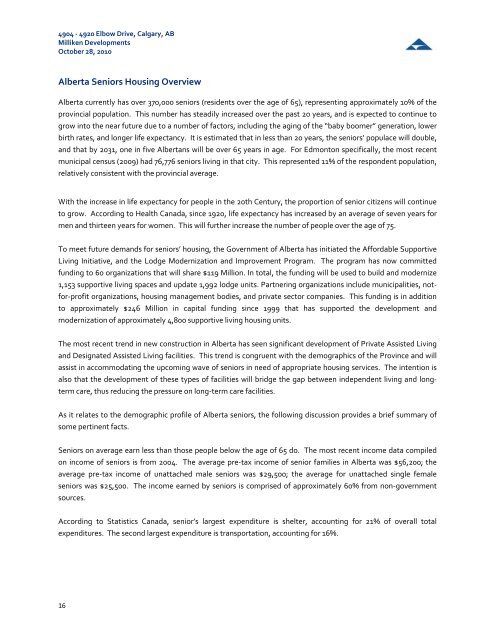Altus Feasibility Study (pdf) - Maison Senior Living
Altus Feasibility Study (pdf) - Maison Senior Living
Altus Feasibility Study (pdf) - Maison Senior Living
Create successful ePaper yourself
Turn your PDF publications into a flip-book with our unique Google optimized e-Paper software.
4904 ‐ 4920 Elbow Drive, Calgary, AB<br />
Milliken Developments<br />
October 28, 2010<br />
Alberta <strong>Senior</strong>s Housing Overview<br />
Alberta currently has over 370,000 seniors (residents over the age of 65), representing approximately 10% of the<br />
provincial population. This number has steadily increased over the past 20 years, and is expected to continue to<br />
grow into the near future due to a number of factors, including the aging of the “baby boomer” generation, lower<br />
birth rates, and longer life expectancy. It is estimated that in less than 20 years, the seniors’ populace will double,<br />
and that by 2031, one in five Albertans will be over 65 years in age. For Edmonton specifically, the most recent<br />
municipal census (2009) had 76,776 seniors living in that city. This represented 11% of the respondent population,<br />
relatively consistent with the provincial average.<br />
With the increase in life expectancy for people in the 20th Century, the proportion of senior citizens will continue<br />
to grow. According to Health Canada, since 1920, life expectancy has increased by an average of seven years for<br />
men and thirteen years for women. This will further increase the number of people over the age of 75.<br />
To meet future demands for seniors’ housing, the Government of Alberta has initiated the Affordable Supportive<br />
<strong>Living</strong> Initiative, and the Lodge Modernization and Improvement Program. The program has now committed<br />
funding to 60 organizations that will share $119 Million. In total, the funding will be used to build and modernize<br />
1,153 supportive living spaces and update 1,992 lodge units. Partnering organizations include municipalities, not‐<br />
for‐profit organizations, housing management bodies, and private sector companies. This funding is in addition<br />
to approximately $246 Million in capital funding since 1999 that has supported the development and<br />
modernization of approximately 4,800 supportive living housing units.<br />
The most recent trend in new construction in Alberta has seen significant development of Private Assisted <strong>Living</strong><br />
and Designated Assisted <strong>Living</strong> facilities. This trend is congruent with the demographics of the Province and will<br />
assist in accommodating the upcoming wave of seniors in need of appropriate housing services. The intention is<br />
also that the development of these types of facilities will bridge the gap between independent living and long‐<br />
term care, thus reducing the pressure on long‐term care facilities.<br />
As it relates to the demographic profile of Alberta seniors, the following discussion provides a brief summary of<br />
some pertinent facts.<br />
<strong>Senior</strong>s on average earn less than those people below the age of 65 do. The most recent income data compiled<br />
on income of seniors is from 2004. The average pre‐tax income of senior families in Alberta was $56,200; the<br />
average pre‐tax income of unattached male seniors was $29,500; the average for unattached single female<br />
seniors was $25,500. The income earned by seniors is comprised of approximately 60% from non‐government<br />
sources.<br />
According to Statistics Canada, senior’s largest expenditure is shelter, accounting for 21% of overall total<br />
expenditures. The second largest expenditure is transportation, accounting for 16%.<br />
16


